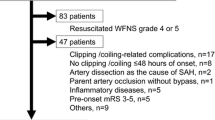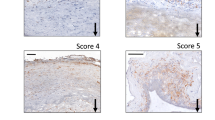Abstract
Purpose
Oxidized low-density lipoprotein receptor 1 (LOX1) is a critical factor for atherosclerosis in a variety of vascular diseases; however, its major role in cerebral arterial dissecting aneurysm is unclear.
Clinical presentation
We present a case of remarkable contrast of LOX1 expression in ruptured and unruptured multiple middle cerebral artery dissections and discuss the correlation of LOX1 with matrix metalloproteinases (MMPs). A 59-year-old woman presented with subarachnoid hemorrhage associated with left temporal subcortical hematoma. Emergent cerebral angiography demonstrated aneurysmal dilatation at the origin of the left anterior temporal artery (ATA) and occlusion on the distal side of ATA. Infectious aneurysm was excluded. Intraoperative findings showed ruptured dissection of the left ATA and unruptured aneurysmal dilatation of another temporal branch of the left M1 portion. Both lesions were trapped by clips and resected. Histopathological examination confirmed that both ruptured and unruptured aneurysmal dilatations were diagnosed as arterial dissections. Immunohistochemical examination demonstrated remarkable expressions of LOX1, MMP-2, and MMP-9 in hypertrophic media outside the intima in ruptured dissection, on the other hand, those expressions in the intima and inside hypertrophic media in the unruptured dissection.
Conclusions
This is the first report to reveal immunohistochemical findings of LOX1 and MMPs in multiple dissections of MCA. The contrast localization of LOX1 and MMPs might contribute to the fragility of the arterial wall layer of ruptured/unruptured arterial dissections.





Similar content being viewed by others
References
Abiko S, Okamura T, Kurokawa Y, Ikeda N, Ideguchi M, Watanabe K (1999) Diagnosis in the middle cerebral artery [in Japanese]. No Shinkei Geka 27:743–749
Alvarez B, Ruiz C, Chacon P, Alvarez-Sabin J, Matas M (2004) Serum values of metalloproteinase-2 and metalloproteinase-9 as related to unstable plaque and inflammatory cells in patients with greater than 70% carotid artery stenosis. J Vasc Surg 40:469–475
Aoki T, Kataoka H, Morimoto M, Nozaki K, Hashimoto N (2007) Macrophage-derived matrix metalloproteinase-2 and -9 promote the progression of cerebral aneurysms in rats. Stroke 38:162–169
Chen XP, Zhang TT, Du GH (2007) Lectin-like oxidized low-density lipoprotein receptor-1, a new promising target for the therapy of atherosclerosis? Cardiovasc Drug Rev 25:146–161
Fridman AH, Drake CG (1984) Subarachnoid hemorrhage from intracranial dissecting aneurysm. J Neurosurg 60:325–334
Fu Y, Komiyama M, Inoue T, Ohata K, Matsuoka Y, Hakuba A (1996) A case of middle cerebral artery occlusion caused by dissecting aneurysm [in Japanese]. No Shinkei Geka 24:955–959
Fujimura M, Gasche Y, Morita-Fujimura Y, Massengale J, Kawase M, Chan PH (1999) Early appearance of activated matrix metalloproteinase-9 and blood–brain barrier disruption in mice after focal cerebral ischemia and reperfusion. Brain Res 18:92–100
Grosman HY, Fornasier VL, Bonder D, Livingston KE, Platte ME (1980) Dissecting aneurysm of the cerebral arteries. J Neurosurg 53:693–697
Hashimoto H, Iida J, Shin Y, Hironaka Y, Sakaki T (1999) Subarachnoid hemorrhage from intracranial dissecting aneurysms of the anterior circulation: two case reports. Neurol Med Chir (Tokyo) 39:442–446
Hashimoto N, Suzuki O, Takakubo Y, Mori I, Nagai H (1995) A dissecting aneurysm of the middle cerebral artery: a case report [in Japanese]. No Shinkei Geka 4:281–286
Ingueneau C, Huynh-DoU TJC, Negre-Salvayre A, Salvayre R, Vindis C (2008) Caveolin-1 sensitizes vascular smooth muscle cells to mildly oxidized LDL-induced apoptosis. Biochem Biophys Res Comm 369:889–893
Ishino S, Mukai T, Kuge Y, Kume N, Ogawa M, Takai N, Kamihashi J, Shiomi M, Minami M, Kita T, Saji H (2008) Targeting of lectinlike oxidized low-density lipoprotein receptor 1 (LOX-1) with 99mTc-labeled anti-LOX-1 antibody: potential agent for imaging of vulnerable plaque. J Nucl Med 49:1677–1685
Kamiyama H, Nomura M, Abe H, Abumiya T, Saito H, Yamauchi T, Saitoh H (1990) Diagnosis for the intracranial dissecting aneurysms [in Japanese]. Surg Cereb Stroke 18:50–56
Kawaguchi T, Kawano T, Kazekawa K, Honma T, Kaneko Y, Koizumi T, Dousaka Y (1997) Dissecting aneurysm of the middle cerebral artery with subarachnoid hemorrhage and brain infarction [in Japanese]. No Shinkei Geka 25:1033–1037
Kim SC, Singh M, Huang J, Prestigiacomo CJ, Winfree CJ, Solomon RA, Connolly ES Jr (1997) Matrix metalloproteinase-9 in cerebral aneurysms. Neurosurgery 41:642–666
Kunze S, Schiefer W (1971) Angiographic demonstration of a dissecting aneurysm of the middle cerebral artery. Neuroradiology 2:201–206
Mizutani T (1998) Subarachnoid hemorrhage associated with angiographic stenotic or occlusive lesions in the carotid circulation. Surg Neurol 49:495–504
Nakajima S, Nomura S, Tomokiyo M, Furukawa Y, Shimokawa N, Nakagawa S, Anegawa S, Hayashi T (2002) Dissecting aneurysm of the middle cerebral artery with subarachnoid hemorrhage showing complete occlusion at the M2 portion of the middle cerebral artery on preoperative angiogram: case report [in Japanese]. No Shinkei Geka 30:541–545
O’Brien KD, Allen MD, McDonald TO, Chait A, Harlan JM, Fishbein D (1993) Vascular cell adhesion molecule-1 is expressed in human coronary atherosclerotic plaques: implications for the mode of progression of advanced coronary atherosclerosis. J Clin Invest 92:945–951
Sakamoto S, Ikawa F, Kawamoto H, Ohbayashi N, Inagawa T (2003) Acute surgery for ruptured dissecting aneurysm of the M3 portion of the middle cerebral artery. Neurol Med Chir (Tokyo) 43:188–191
Witztum JL, Steinberg D (1991) Role of oxidized low density lipoprotein in atherosclerosis. J Clin Invest 88:1785–1792
Author information
Authors and Affiliations
Corresponding author
Additional information
Comment
The case reported is a very interesting and well-documented. Moreover, the authors provide a well-written introduction as to why the case described would be an interesting one and why they performed the immunohistochemical studies described. Furthermore, the discussion of the case and its histological presentation include interesting speculations that might have broader implications to other types of intracranial aneurysms and their etiology which still remains to be elucidated.
Juhana Frösen
Mika Niemelä
Juha Hernesniemi
Helsinki, Finland
This well-written report is interesting for many aspects:
1. The relative rarity of arterial dissections in the anterior circulation, particularly when MCA is affected. The involvement of the M3 portion is even rarer, exceptional when the dissecting aneurysm is localized on multiple temporal branches of MCA.
2. The unusual and clearly depicted intraoperative illustration that the unruptured lesion dilated after surgical manipulation with the penetration of blood flow and progression of arterial dissection.
3. The novel observation that immunohistochemical findings of LOX1 and MMP immunoreactivities were observed in the hypertrophic collagenous layer of the dissecting arterial wall in the ruptured dissection and in the hypertrophic intimal layer in the unruptured dissection.
Although an intriguing theory, at the present stage, the contribution of different localization of LOX1 and MMPs to the fragility of the arterial wall layer of ruptured/unruptured arterial dissections can be discussed only on a conjectural basis, and much more observations are needed before one can advance a robust pathophysiological interpretation.
Domenico d'Avella
Padova, Italy
Rights and permissions
About this article
Cite this article
Saito, A., Fujimura, M., Inoue, T. et al. Lectin-like oxidized low-density lipoprotein receptor 1 and matrix metalloproteinase expression in ruptured and unruptured multiple dissections of distal middle cerebral artery: case report. Acta Neurochir 152, 1235–1240 (2010). https://doi.org/10.1007/s00701-009-0560-6
Received:
Accepted:
Published:
Issue Date:
DOI: https://doi.org/10.1007/s00701-009-0560-6




